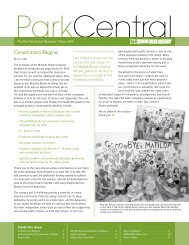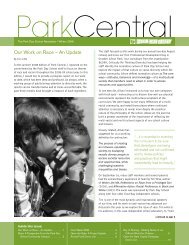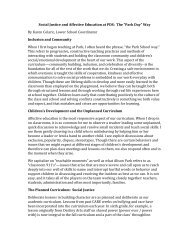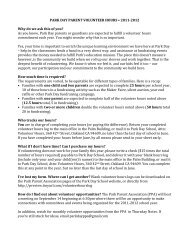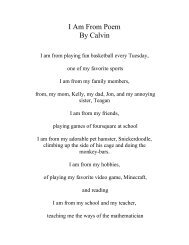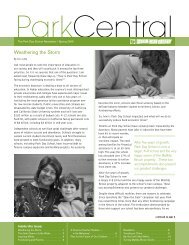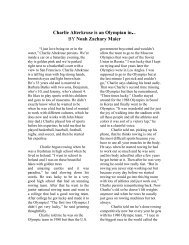Pick up Park Central, 2012 - Park Day School
Pick up Park Central, 2012 - Park Day School
Pick up Park Central, 2012 - Park Day School
You also want an ePaper? Increase the reach of your titles
YUMPU automatically turns print PDFs into web optimized ePapers that Google loves.
P A R K D A Y S C H O O L<br />
3 6 0 4 2 N D S T .<br />
O A K L A N D , C A 9 4 6 0 9<br />
<strong>Park</strong> <strong>Central</strong><br />
5 1 0 - 6 5 3 - 0 3 1 7<br />
W I N T E R 2 0 1 2<br />
On Character<br />
T H E N E W S L E T T E R O F P D S<br />
I N S I D E T H I S<br />
I S S U E :<br />
Tom Little, <strong>Park</strong> <strong>Day</strong> <strong>School</strong> Director<br />
On<br />
Character<br />
1,<br />
12-13<br />
To what extent is the development of a child’s character the province of a school?<br />
Faculty 2-3<br />
Spotlight<br />
Alumni Profile 5<br />
Every day, children face moral and ethical situations and decisions as they navigate<br />
Asking Good<br />
Questions<br />
Tom 25<br />
Thanks<br />
Care Week<br />
2011 Snapshots<br />
Alumni<br />
Facebook<br />
6-8<br />
9<br />
10<br />
12<br />
their lives and relationships at home and school. When one witnesses a friend being unkind<br />
to another; when classmates are conspiring to play an online trick on one of the other<br />
children and they’ve asked someone else to join in; when a teacher hands back an assignment<br />
and says, “You can do better; I want you to do this over again.” In small and<br />
big ways, in their real and virtual worlds, children are constantly confronted with hard<br />
choices that will come to define their character.<br />
It’s complicated and messy business. In the introduction to their wonderful compendium<br />
of poems, stories and fables, A Call to Character, editors Colin Greer and Herb Kohl<br />
write:<br />
…children grow and test out their strengths and values against the world.<br />
They do dangerous things, fall into and out of trouble, and invent<br />
preposterous schemes. But they also charm and move us by their unexpected<br />
insights into emotions and character and their passionate concern for others.<br />
Moral development takes place slowly.<br />
I define character as the sum of personal attributes and traits that define a person. These<br />
traits and attributes include an individuals values, ethical beliefs and morals, and define<br />
<strong>Park</strong> <strong>Central</strong> would<br />
like to extend a<br />
special thanks to Flo<br />
Hodes, Assistant<br />
<strong>School</strong> Director, for<br />
s<strong>up</strong>port in editing.<br />
one’s individual’s actions, relationships and responses.<br />
As such, one might assume that the development of these aspects of being human falls<br />
more appropriately into the purview of the family, religious institution, and/or perhaps<br />
psychologist or mental health practitioner. But, given the amount of time children spend<br />
at school and in the presence of teachers, it is not hard to argue that school life has an<br />
enormous impact on the moral and ethical development of our youth.<br />
Cont. on Page
P A G E 2<br />
Faculty Spotlight:<br />
Meena Srinivasan, 6th Grade<br />
Jeanine Harmon, Community Outreach Coordinator<br />
We are counting our lucky stars this year at <strong>Park</strong> <strong>Day</strong> <strong>School</strong>. Why?<br />
Because Meena Srinivasan joined our staff this fall as the new sixth<br />
grade humanities teacher. Believe it or not, Meena heard about the<br />
opening for this position from a former <strong>Park</strong> <strong>Day</strong> family while teaching at the American<br />
Embassy <strong>School</strong> in Delhi.<br />
Meena comes to us with a wealth of experience and passion for education and social justice.<br />
If you haven’t met Meena yet, here’s an opportunity to get to know her.<br />
What inspired you to become a teacher?<br />
For me, teaching is definitely a calling. I have committed my professional life to articulating<br />
an ethical, ecological, humanistic approach to education and I strive to craft innovative<br />
curriculum that promotes efficacy and empathy. After all, in the words of <strong>Park</strong>er Palmer,<br />
"to educate is to guide students on an inner journey toward more truthful ways of seeing<br />
and being in the world." Right after I graduated from college I moved to Brazil for one<br />
year because one of my mentors at the Woodrow Wilson Center in Washington DC did the<br />
Peace Corp in Brazil and I became absolutely fascinated! When I was in Brazil I taught<br />
seventh, eighth and ninth grade social studies at an international school in Sao Paulo. Brazil<br />
changed my life and I loved the time I spent there. In Brazil everyone was fascinated<br />
with my Indian ancestry. They would ask me about India but I didn’t have much to share<br />
since I had only been to India a handful of times. I didn’t have a car and there was a yoga<br />
studio near my home where I spent most of my time. I even volunteered to bring some<br />
basic yoga to a favela (slum) every week. In Brazil, for the first time I was able to really<br />
reflect on the questions I never had time for in high school or college because I was so<br />
busy and focused on being “successful.”<br />
Sister Jewel & Meena<br />
My time in Brazil opened <strong>up</strong> my world in so many ways. I traveled all over the country,<br />
immersed myself in spiritual studies, started practicing meditation and met so many special,<br />
inspiring people. Most importantly, I fell in love with teaching. I never, ever thought<br />
I’d become a schoolteacher! When my year in Brazil ended, I moved to New York City<br />
where I spent one year working at the ABC Network in their hard news division. Before<br />
Brazil, I was certain that I wanted to be a foreign news producer. But I didn’t enjoy my<br />
time at ABC, and while I learned a lot, I was unhappy every day as I walked from my<br />
charming studio apartment in the Upper West Side to my office near Columbus Circle. I<br />
missed teaching and was literally creating lesson plans while I was at work! Well, the day<br />
Saddam Hussain was captured and work at ABC was absolutely crazy, a voice inside of me<br />
said: “You don’t have to do this. You really don’t have to do this.” I literally jumped out of<br />
my seat, my energy shifted and I just felt free! My mind was trying to convince me that I<br />
had had my year in Brazil, I had had my post-college fun, and now it was time to get down<br />
to business with my career; but my heart told me that New York and ABC were all wrong.<br />
Within a month I found a great job teaching at Head-Royce <strong>School</strong> here in Oakland!<br />
P A R K C E N T R A L
W I N T E R 2 0 1 2<br />
P A G E 3<br />
What was it like teaching at the American Embassy <strong>School</strong> in Delhi?<br />
I loved my time at the American Embassy <strong>School</strong>. It’s one of the world’s leading international schools and I taught<br />
both high school and middle school, in addition to leading International Peace <strong>Day</strong> activities. My students and colleagues<br />
were amazing, and living in India was fascinating. While I was there I organized Delhi's first ever "Yogathon<br />
to S<strong>up</strong>port Education for All;" visits of His Holiness the Karmapa; a week-long trip to work on an organic farm in<br />
Dehradun and learn about sustainability; and the visit of Dr. Jon and Mrs. Myla Kabat-Zinn. I was also a leader in a<br />
community of mindfulness practice for educators. I spent my last year in India engaging in an experiment, “A Year of<br />
Mindfulness in the Classroom,” which evolved into a teaching tool for mindful educators worldwide.<br />
I’m currently in the midst of qualitative research on the teaching of mindfulness to my<br />
6 th grade’s in a health education class I taught in India. It was difficult to leave the American "There is no question in my mind<br />
Embassy <strong>School</strong>, but I knew it was time for a new adventure and <strong>Park</strong> <strong>Day</strong> is the perfect place<br />
that Meena was born to make a<br />
for me! It was amazing for me to find a school in the United States where I could invite the bell<br />
and weave mindful practice into my humanities lessons! I have a lot to learn and a long way to difference in the world. In every<br />
go, but am grateful to be at a school that is s<strong>up</strong>portive of bringing mindfulness and social justice gro<strong>up</strong> Meena's radiance shines<br />
into the lives of young people.<br />
through and her leadership<br />
We really enjoyed meeting your friend, Sister Jewel during her visit on International Peace<br />
<strong>Day</strong>. What was that experience like for you and your students?<br />
Sister Jewel is a dear friend and teacher to me. She is the editor of Thich Nhat Hanh’s recent<br />
book, Planting Seeds: Practicing Mindfulness with Children, which I contributed to. We ran<br />
mindfulness programs for educators in India and I’m always touched by her embodiment of the<br />
practice. For me, monastics anchor the practice, and my students really felt the peacefulness Sister<br />
Jewel exuded when they were in her space. They wrote her beautiful letters, and I think the<br />
experience is something our class will not forget.<br />
What are you enjoying about being back in the Bay Area?<br />
emerges. She is blessed with an<br />
exceptional intellect, insatiable<br />
curiosity, a vibrant personality,<br />
and limitless energy. Her rapport<br />
with kids is based on a zest for<br />
life and a commitment to<br />
service. In so many ways, she is<br />
the ideal role model for young<br />
I love the Bay Area and the East Bay in particular. I feel like the folks here are my “peeps.” If<br />
you are intellectually curious, progressive and culturally aware I don’t think there is a better<br />
place to live in the United States! I also love the natural beauty of this area.<br />
people. She is an exceptional<br />
educator and individual that<br />
makes the world a better place<br />
just by being in it."<br />
What would people be surprised to learn about you?<br />
- Robert W. Hetzel, Ph.D.,<br />
Apparently I’m the youngest Western woman (and quite possibly non-Tibetan lay practitioner)<br />
to have traveled to Tibet’s Mount Kailash alone (without any family, friends, spiritual teacher Director, The American Embassy<br />
or sangha) and successfully complete the entire parikrama (circumambulation) on foot without <strong>School</strong> - New Delhi, India<br />
the aid of a porter. I’ve hung out with the King of Bhutan and was close friends with the late<br />
Professor Ramchandra Gandhi (Mahatma Gandhi’s grandson). Also, when I was in fifth grade I<br />
started a direct action campaign to get rid of styrofoam lunch trays. I got almost the entire elementary school to sign a<br />
petition, met with the school board and principal and finally<br />
got the school to change their trays. Until they got<br />
new trays I brought my own plate to school.<br />
Meena has been a wonderful addition to the <strong>Park</strong> <strong>Day</strong><br />
<strong>School</strong> staff and community.<br />
Meena’s 6th Grade Class with Sister Jewel
P A G E 4<br />
<strong>Park</strong> <strong>Day</strong> <strong>School</strong> Annual Giving<br />
Each year, <strong>Park</strong> <strong>Day</strong> <strong>School</strong> families, as well as alumni and their families,<br />
board members, grandparents, faculty and staff, s<strong>up</strong>port our mission and<br />
how we deliver a quality progressive education through their s<strong>up</strong>port of the<br />
<strong>Park</strong> <strong>Day</strong> <strong>School</strong> Annual Fund.<br />
Every gift, no matter what the size, is significant<br />
and takes us one step closer to our goal.<br />
• This year’s Annual Fund goal is $175,000. We are striving for 100%<br />
Annual Fund participation from current families, as well as teachers,<br />
staff, and Board members.<br />
• Annual Fund gifts s<strong>up</strong>port faculty salaries to attract and retain the<br />
best teachers while enhancing professional development programs.<br />
• Annual Fund gifts also help ensure the rich economic diversity of our<br />
community by enabling us to keep tuition increases minimal each<br />
year, and s<strong>up</strong>port our ability to provide financial assistance to<br />
approximately<br />
46% of our families annually.<br />
P A R K C E N T R A L
W I N T E R 2 0 1 2<br />
P A G E 5<br />
Alumni Profile: Brian Herndon<br />
Brian Herndon is a <strong>Park</strong> <strong>Day</strong> <strong>School</strong> alumni with a unique connection<br />
to our school. Not only was Brian a student in the very<br />
first class of <strong>Park</strong> <strong>Day</strong> <strong>School</strong>, his teacher happened to be a brand<br />
new teacher named Tom Little.<br />
Tom says, “There were seven students in the first class and<br />
Brian, who was five years old at the time, was the youngest. The<br />
day I met him he was carrying Ovid's Metamorphosis, which he<br />
could actually decipher and fully comprehend. He'd become a<br />
student of Greek mythology at a very young age and our class<br />
put on a production of Theseus and the Minotaur, directed<br />
by Brian's mother, Marge Herndon.”<br />
Brian Now...<br />
In the early years of <strong>Park</strong> <strong>Day</strong> <strong>School</strong>, the school was located<br />
on several sites. Brian was a student on two of them: at Synergy<br />
on <strong>Park</strong> Boulevard and at Montclair Presbyterian Church.<br />
That book-carrying five-year-old grew <strong>up</strong> to be a man with a<br />
love of acting and teaching. For the past twelve years Brian has<br />
been the drama/stage contact and chorus teacher at Odyssey Middle<br />
<strong>School</strong> in San Mateo. Brian says, “When I first stepped on<br />
campus at Odyssey it felt like déjà vu. The school felt so similar<br />
to <strong>Park</strong> <strong>Day</strong> in its philosophy and its environment. This past year<br />
I encouraged the new head of school at Odyssey to connect with<br />
Tom, particularly around the mindfulness program. It was one of<br />
the best decisions. I was happy to be part of this introduction.”<br />
Brian has also been teaching in the Actor’s Training Program<br />
at Solano College, as well as teaching beginning acting for opera<br />
singers at San Francisco Conservatory of Music. He's had the<br />
opportunity to work with former and current <strong>Park</strong> <strong>Day</strong> students at<br />
Berkeley Playhouse. You may have seen Brian acting in past<br />
summers in the San Francisco Shakespeare Festival or at Theatreworks<br />
in Palo Alto. Up next he'll be performing in the world<br />
premiere of Truffaldino Says No at Shotgun Players in July <strong>2012</strong>.<br />
...and In 1976<br />
Brian (Center) in Tom’s Class c.1977<br />
Brian and his family live in the Haight neighborhood in San<br />
Francisco. When he's not teaching or acting, he's probably out<br />
running or at a cooking class with his four and a half year-old<br />
daughter Gwen.<br />
"I appreciate the kindness that <strong>Park</strong> <strong>Day</strong> instills in every one<br />
of its students. In this incredibly competitive world I think being<br />
cognizant of others' feelings is undervalued, and ironically it's<br />
been a huge part of my successes. I'm proud to be a <strong>Park</strong> <strong>Day</strong><br />
alumnus!"<br />
Brian (Far Right) as Hermes in Theseus and<br />
the Minotaur. Brian’s Mother Marge (Center)
P A G E 6<br />
Asking Good Questions<br />
Renee Miller, Third Grade Teacher<br />
Language is the essential condition of knowing, the process by<br />
which experience becomes knowledge. -Michael Halliday<br />
Sometimes there is a magic that happens in a classroom that is hard to explain to the outsider.<br />
It’s the juicy goodness that keeps kids interested in school and active participants in their learning.<br />
It’s the stuff that keeps teachers motivated and the classroom dynamic. I don’t know how all of that<br />
happens, but here I will try to tell you about one thing that I know for sure: Good teachers know<br />
how to ask good questions.<br />
The key to deep learning lies not in the regurgitation of facts but in the ability to consider, grapple<br />
with, reason about and use what is being learned. The art of effective teaching is founded on the<br />
use of questioning strategies to enhance the development of student understanding and problem<br />
solving by using higher order thinking skills.<br />
How do we design lessons where developing understanding is the primary goal? What does it<br />
look like to build a classroom environment where all students are moving forward with their conceptual<br />
understanding of mathematics and their ability to make sense of problems around them? It all<br />
comes back to the questions we ask.<br />
Good questions can transform a classroom into a vibrant learning community where each student<br />
is invested and willing to become engaged. I’m not talking about those sorts of questions that call<br />
for nothing more than a calculation and for which there is only one answer that requires no further<br />
thought on the part of the student. I’m talking about good questions that perplex and puzzle us,<br />
amuse and interest us. Those questions that allow us to use the math tools we already have to solve<br />
new problems and move us further along on our path of mathematical ability.<br />
We know that children learn best when they can build meaning of a concept for themselves. Rather<br />
than teaching by telling, teachers structure learning activities and ask questions that provide<br />
learners with opportunities to make sense. This is best done by allowing for social interaction and by<br />
providing children opportunities to think, reason, and communicate.<br />
P A R K C E N T R A L
W I N T E R 2 0 1 2<br />
P A G E 7<br />
Good questions allow teachers to assess students and to trigger deeper thinking. But I believe,<br />
most importantly, asking good questions prompts discourse, which is an integral part of the teaching<br />
and learning in a math classroom. When students are set <strong>up</strong> to talk, they develop the ability to<br />
explain their own thinking, which helps improve their conceptual understanding.<br />
Teachers pose hundreds of questions each day, and while engaging students in discussion we<br />
consider what happens in the exchanges after the question is posed. What does the interaction look<br />
like? When good questions are posed, the pattern of interaction encourages students to participate<br />
further and shows that students’ thinking is valued. There is a buzz about the room and all students<br />
are working. When we ask good questions, we get kids talking, to us and to each other.<br />
When students are given the opportunity to engage in discourse a whole<br />
host of benefits arise. They can clarify their own thinking and come to feel<br />
grounded in their ideas, or catch mistakes and misunderstandings that they<br />
hold. Students can garner peer s<strong>up</strong>port in testing strategies to see if they are<br />
mathematically logical. Students can hear and learn from the ideas of their<br />
peers, which aids in the building of a repertoire of efficient problem solving<br />
tools and strategies. In each of these scenarios the child is empowered and<br />
the teacher moves to the role of facilitator, or question asker.<br />
If you were a fly on the wall in a math classroom where developing understanding<br />
and promoting dialogue were central, you might hear questions such as these:<br />
• How is this problem like ones you’ve solved in the past?<br />
• Do you have any ideas about where this problem is heading?<br />
• What do you already know that is going to help you keep going?<br />
• What steps did you take to get to this point?<br />
• Will you turn to a neighbor and let them know why you think the answer you have is correct?<br />
• What do you notice?<br />
• Do you see any patterns?<br />
Good questions make room for all learners. When I think about my own learning journey and<br />
the times when I learned something new, in each instance there was a question that lingered, unanswered,<br />
that motivated me to move toward an answer.<br />
“Good questions can<br />
transform a<br />
classroom into a<br />
vibrant learning<br />
community where<br />
each student is<br />
invested and willing<br />
to become engaged.”
Asking Good Questions Cont.<br />
P A G E 8<br />
Recently, Gretchen and I spoke at a <strong>Park</strong> Parents Association meeting and posed this question to the parents:<br />
Without jumping to Algebra, how might you approach these problems?<br />
Chicken and Pigs<br />
A farmer walks outside and looks at her land and animals. As she is admiring the scene she notices that<br />
her pigs and chickens are hanging out together.<br />
In the mix she counts 11 heads and 38 feet.<br />
Is there any way to know how many pigs and how many chickens the farmer had?<br />
How can you use the information about heads and feet to figure this out?<br />
• Let me know what you come <strong>up</strong> with.<br />
• For those of you who’ve already solved that one, or for those who would like another, here’s a new<br />
problem to think about. It’s one that can get people talking. It’s simple enough so that it can be approached<br />
by just about anyone, but complex enough to draw out a variety of solutions. The answer<br />
isn’t at first apparent.<br />
Dealing in Horses<br />
A man bought a horse for $50 and sold it for $60. He then bought the horse back for $70 and sold it<br />
again for $80. What do you think the financial outcome was for this man? Did he make money or lose<br />
money? How much money did he make or lose?<br />
Find a way to explain your thinking and to PROVE that your answer is correct. Then ask your kid,<br />
spouse, or friend to do the same.<br />
P A R K C E N T R A L
W I N T E R 2 0 1 2<br />
P A G E 9<br />
The evening of October 25 th was for me a once-in-a-lifetime gift that I will never<br />
forget. I am deeply grateful to the community of staff, alumni, and former parents who<br />
took part in the event. Each time I turned around, there was another beloved face from<br />
the past. I was overjoyed and very moved by the outpouring of love and affection.<br />
Many thanks to our Development Director, Ryan Helton, and former Community<br />
Outreach Coordinator, Laurie Grossman for planning the event; they kept most of the<br />
proceedings a secret and I was surprised and delighted by every turn. A special thanks<br />
to all who donated to our Community Outreach Program in recognition of my 25 th<br />
anniversary. As I have always said, I am a very privileged man to sit in this position as<br />
Director of <strong>Park</strong> <strong>Day</strong> <strong>School</strong>. This event was another example.<br />
Thank you,<br />
Tom Little, Director<br />
<strong>Park</strong> <strong>Day</strong> <strong>School</strong><br />
Tom’s 25th Anniversary Celebration
P A G E 1 0<br />
CARE<br />
Week 2011<br />
One of our signature traditions at <strong>Park</strong> <strong>Day</strong><br />
<strong>School</strong> is CARE Week (Campaign for<br />
Acceptance, Respect and Empathy). This year<br />
our theme was “How Can I/We Make a<br />
Difference?” Over the course of this year's CARE<br />
Week we had the opportunity to meet and work<br />
with people from the following organizations:<br />
Brighter Beginnings<br />
Cycles for Change<br />
What If? Foundation<br />
Life Goes On Foundation<br />
Alameda County Food Bank<br />
UNICEF<br />
SEED/Narika<br />
Global Footprint<br />
East Bay Depot for Creative Reuse<br />
Project Linus<br />
We also enjoyed learning about Native American<br />
advocacy, small animal rescue, utility/transit box<br />
art and much more from staff, parents and<br />
friends of <strong>Park</strong> <strong>Day</strong> <strong>School</strong>. The sixth graders<br />
also created wonderful storybook performances<br />
for us. The week ended with a fun, interactive<br />
performance by Playback Theatre. It was a<br />
wonderful, inspiring week.
W I N T E R 2 0 1 2<br />
P A G E 1 1
P A G E 1 2<br />
On Character Cont.<br />
I raise the question now because the need in our society to address character development has rarely been greater. Given<br />
that the current political and economic landscape triggers widespread apathy and cynicism, any chance to achieve social<br />
change begins with the raising of youth whose values deeply reflect and will promote a good and virtuous society.<br />
Indeed, we school folks have the obligation to achieve a degree of expertise in assessing, understanding and fostering<br />
the positive social and emotional development of children, and to keep close tabs on their moral and ethical growth.<br />
Through history, this has been a topic of debate and controversy.<br />
Aristotle wrote that it is no easy task to be good, and not easy to define virtue through rules of human behavior. Plato,<br />
through Socrates, recognized that “excellence of character,” or virtue, could not be taught unless conveyed as knowledge,<br />
and the virtue must be discussed every day for a man to be virtuous.<br />
In the early days of the common school in America, schools were seen as transmitters of what it would take to be a<br />
good and <strong>up</strong>standing person. Lots of rules, heavy discipline, and the modeling of “proper” teachers were all tools to inculcate<br />
a moral code. This practice diminished over time in education in favor of allowing for “personal choice,” as the<br />
righteousness of the commonly held moral code dissolved to become a matter of individual privacy. When I was teaching<br />
in the 70’s, a “values clarification” movement prevailed in schools, in which teachers helped students discover their<br />
own values and learn to analyze ethical situations. Still, schools were reluctant to assert a standard of moral and ethical<br />
conduct. Character development can often be relegated to civics class and center around the citizenship theme. Or, it<br />
manifests in moralistic lectures from teachers or school leaders. “I remember when a teacher once told me…”<br />
But, things may be changing rapidly.<br />
In a recent provocative NY Times article, Paul Tough contrasts two schools (one an affluent independent school, and<br />
one an inner-city charter school) in their efforts to approach character education. Both schools have assumed the responsibility<br />
to evaluate students not just on their academic growth, but also on how well they demonstrate strength of character.<br />
In one of the schools, not only are students graded in math, science and English, they also receive grades in two dozen<br />
character indicators such as optimism, zest, and curiosity. There is no ambivalence on the part of these school leaders<br />
– the development of morals, ethics, and virtues falls solidly in the laps of educators, who should be holding students to<br />
the highest standards of character.<br />
[The article appears at: http://nyti.ms/qzavYS]<br />
Through this article, I was exposed to (and now have my hands on) the landmark work of Christopher Peterson and<br />
Martin Seligman, Character Strengths and Virtues: A Handbook and Classification. Their work aspires to the same stature<br />
in the mental health profession as the DSM (Diagnostic and Statistical Manual), the widely used guide to diagnosing<br />
mental disorders. But, Peterson and Seligman are practitioners in the “Positive Psychology” movement and their aspirations<br />
lend to the assessment and cultivation of character. They are approaching the questions – What are universally held<br />
virtues? How can we assess if an individual possesses these virtues? And, critically, how can we establish a curriculum or<br />
course of study to help students acquire these character strengths? Among the traits that seem to hold as universally desirable<br />
are kindness (social intelligence), optimism, persistence, courage, integrity, fairness, self-regulation, and gratitude.<br />
Identifying these virtues and character strengths clearly defines for educators a moral and ethical high ground.
W I N T E R 2 0 1 2<br />
P A G E 1 3<br />
As teachers, the better we become at assessment, the more we can gain insight into children’s character<br />
development. Over the years I have assembled a set of questions that teachers can incorporate into their assessment<br />
repertory when examining student behavior. These questions probe into the way children approach<br />
relationships, how they handle conflict, how they interact with others in cooperative learning activities, what<br />
is their social demeanor, and if there is emerging empathy and concern for others.<br />
There also exists in the psychological literature many measures of integrity, kindness,<br />
fairness, perspective-taking, and social responsibility. There is even a measure<br />
of forgiveness.<br />
All of these tools help to identify the formation of a child’s moral identity, and<br />
their use should become as second nature to teachers as the semi-annual math<br />
assessments administered at the beginning and end of the school year. But, we<br />
have yet to widely incorporate these instruments in elementary schools.<br />
At the Willows <strong>School</strong> in Gladstone, N.J., the faculty and staff not only see<br />
themselves as teachers of ethical behavior, but also models of virtuous living.<br />
Each month of the school year is devoted to the focus on a particular virtue (i.e.<br />
compassion, prudence, loyalty courage), and the school expects parents to partner<br />
in reinforcing these behaviors at home. In their mission statement, Willow claims,<br />
“The Willow <strong>School</strong> education enables children to develop an ethical approach to<br />
all relationships, to realize their full potential, and to believe in their power to<br />
effect positive change.”<br />
Recently, our fifth graders wrote brief narratives describing a situation from<br />
three different perspectives. Developmentally, this is a good age for children to<br />
engage in such exercises, as abstract thinking emerges. Teachers can read children<br />
a story such as Eleven, by Sandra Cisneros, and ask students to reflect from various<br />
perspectives on the ethical questions posed by the story, and contrast these<br />
perspectives with their own. This activity is a good example of how teachers can<br />
encourage empathy and perspective-taking.<br />
In the classroom or on the playground at <strong>Park</strong> <strong>Day</strong> <strong>School</strong>, I often see teachers<br />
posing important ethical questions to students. In the maelstrom of a busy school day, it would be easy for a<br />
teacher to simply impose a consequence or send kids off to work things out on their own. Yet, time and<br />
again, I witness teachers modeling appropriate language and posing questions that lead students to examine<br />
the choices they are making. We take this work seriously, and understand that engaging in deep and critical<br />
analysis of ethical and moral situations can help students develop character strength. Emblazoned in our<br />
collective moral conscience is Dr. Martin Luther King’s entreaty that his children (and by extension all children)<br />
be “judged by the content of their character.” We will continue to develop more strategies because we<br />
believe that is one of our essential duties as educators.<br />
Peterson & Seligman’s Classification of<br />
Human Strengths of Character<br />
(from Character Strengths and Virtues: A<br />
Handbook and Classification)<br />
Strengths of Wisdom and Knowledge<br />
Creativity<br />
Curiosity<br />
Open-mindedness<br />
Love of Learning<br />
Perspective<br />
Strengths of Courage<br />
Bravery<br />
Persistence<br />
Integrity<br />
Vitality (Zest, Enthusiasm)<br />
Strengths of Justice<br />
Citizenship<br />
Fairness<br />
Leadership<br />
Strengths of Temperance<br />
Forgiveness and Mercy<br />
Humility and Modesty<br />
Prudence<br />
Self-Regulation<br />
Transcendence<br />
Appreciation of beauty<br />
Gratitude<br />
Hope<br />
Humor<br />
Spirituality
Ever wonder what it would be<br />
like to step back in time?<br />
Now you can find out!!!<br />
Flo, Tom and Alum Siera Rein<br />
Introducing the <strong>Park</strong><br />
<strong>Day</strong> <strong>School</strong> Alumni<br />
Facebook Page!<br />
A 1978 Weekly Staff Meeting<br />
Things To Do:<br />
̌ Share Memories<br />
̌ Find Your Friends<br />
̌ Upload Pictures<br />
̌ See What <strong>Park</strong> Is Up To<br />
<strong>Park</strong> <strong>Day</strong> Staff c.1993<br />
Periodically we’ll be checking<br />
in with questions like: “What’s<br />
your most memorable read-athon<br />
book?” or “Over the<br />
years, what was your favorite<br />
Tom costume?”<br />
The First Year of <strong>Park</strong> <strong>Day</strong>, Student Body and Staff c.1977



